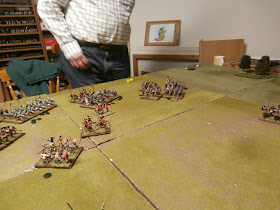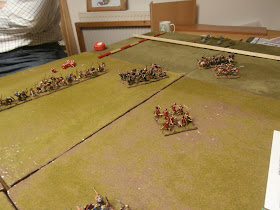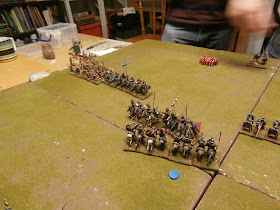 |
| Greek hoplites |
 |
| Close-up of the Greeks |
 |
| The boss looks on |
The temple in the background is one I made a while ago
http://cirencester-wargames.blogspot.co.uk/2016/05/ancient-terrain-greek-punic-temple.html
 |
| Greek hoplites |
 |
| Close-up of the Greeks |
 |
| The boss looks on |
 |
| The Dacians right - cavalry and Falxmen make ready to attack |
 |
| The Roman right with only a single unit of enemy skirmishers opposing it |
 |
| Roman right presses forward |
 |
| The Dacians begin their lengthy wheel |
 |
| Heavy metal clashes |
 |
| Delaying action from the Roman auxiliary and mounted |
 |
| The Romans begin their bloody business against the main line |
 |
| Sarmatians surrounded |
 |
| The main Dacian line still wheeling |
 |
| Romans breach the line |
 |
| The end is nigh |
 |
| Roman left - axillary infantry and mounted |
 |
| Roman centre - the hard lads |
 |
| Roman right - more auxilaires |
 |
| Dacian right - fast-moving Falxmen |
 |
| Dacian left - Sarmatians make ready |
 |
| The Roman left - mostly non-key Auxiliary troops |
 |
| The heavy metal - legionaries and cavalry ready to attack |
 |
| Dacian right - Sarmatians lurking at the back |
 |
| Dacian centre / left - tribesmen sir, thousands of um' |
 |
| Roman attack begins |
 |
| The Dacians start their slooow wheel |
 |
| Pesky Dacian skimishers |
 |
| Roman cavalry catch the Falxmen |
 |
| Legionaries grind forwards |
 |
| Emperor's eye view |
 |
| Sarmatians wait in the distance |
 |
| The lines clash |
 |
| Sarmatians engage the Romans |
 |
| The Romans see-off the outnumbered Sarmatians |
 |
| The Dacian centre crumbles. |
 |
| Dacians home-in on the Auxiliary troops |
 |
| Sarmatian cavalry supported by falx - the heavy rumble of the cataphracts is causing camera shake! |
 |
| The Dacian centre |
 |
| View from the Roman right flank |
 |
| View from the Roman left with our tutor looking on at the assembled hordes |
 |
| Dacian right advances |
 |
| The initial cavalry action - Sarmatians in the ascendancy |
 |
| The second Roman unit takes some heavy hits |
 |
| Roman right - the lights began to wear-down the Dacians |
 |
| Dacians |
 |
| Sarmatian cataphracts |


 |
| Imperial legionaries |
Trajan Romans
|
||||||||
CR:
|
H: 5
|
L: 4
|
BP: 2
|
Init: 7
|
||||
Unit
|
CV
|
Prot
|
Weapons
|
Number
|
Cost
|
Total
|
Core
|
Type
|
Legionaries
|
7 [2] 2
|
+2
|
Pila/Sword
|
3
|
0
|
0
|
Yes
|
COH
|
Auxilia
|
3 [1] 2
|
+2
|
Javelins
|
1
|
0
|
0
|
No
|
SI
|
Cavalry
|
4 [0] 0
|
+1
|
Spear
|
1
|
0
|
0
|
Yes
|
HC
|
Bonus Units
|
||||||||
Legionaries
|
7 [2] 2
|
+2
|
Pila/Sword
|
2
|
13
|
26
|
Yes
|
COH
|
Marines
|
6 [2] 1
|
+1
|
Pila/Sword
|
1
|
9
|
9
|
Yes
|
FT
|
Auxilia
|
4 [1] 2
|
+1
|
Javelins
|
3
|
7
|
21
|
No
|
LHI
|
Auxilia
|
3 [1] 1
|
+1
|
Bows
|
1
|
6
|
6
|
No
|
FT
|
Auxilia
|
3 [1] 2
|
+2
|
Javelins
|
1
|
2
|
2
|
No
|
SI
|
Cavalry
|
4 [0] 0
|
+1
|
Various
|
1
|
10
|
10
|
Yes
|
HC
|
Costs
|
74
|
|||||||
Dacians
|
||||||||
CR:
|
H: 4
|
L: 4
|
BP: 2
|
Init: 4
|
||||
Unit
|
CV
|
Prot
|
Weapons
|
Number
|
Cost
|
Total
|
Core
|
Type
|
Warriors
|
5 [1] 3
|
+1
|
Various
|
7
|
0
|
0
|
Yes
|
WB
|
Archers
|
2 [1] 1
|
+2
|
Bows
|
2
|
0
|
0
|
No
|
SI
|
Javelinmen
|
3 [1] 2
|
+2
|
Javelins
|
3
|
0
|
0
|
Yes
|
SI
|
Bonus Units
|
||||||||
Warriors
|
5 [1] 3
|
+1
|
Various
|
3
|
7
|
21
|
Yes
|
WB
|
Bastarnae
|
5 [1] 2
|
+1
|
Falx
|
2
|
8
|
16
|
No
|
LHI
|
Javelinmen
|
3 [1] 2
|
+2
|
Javelins
|
1
|
2
|
2
|
No
|
SI
|
Noble Cavalry
|
4 [0] 0
|
+1
|
Various
|
1
|
10
|
10
|
Yes
|
HC
|
Sarmatians
|
5 [2] 0
|
+2
|
Lances
|
2
|
12
|
24
|
Yes
|
CAT
|
Costs
|
73
|